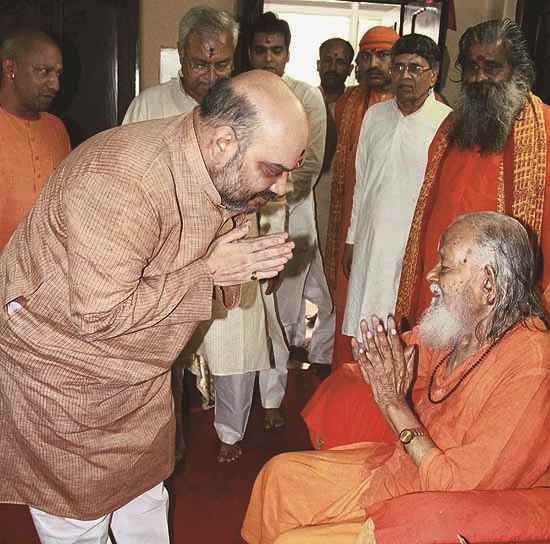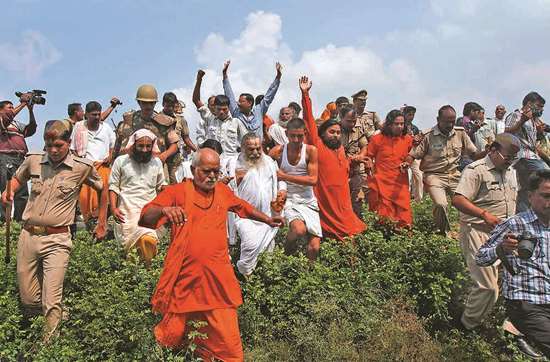In the last one year, Uttar Pradesh has seen a spurt in communal riots incidents. Data from IB reports for the first eight months of the year till August 31 pegs the figure at 80. So it's no coincidence that the politics of projecting Modi as future prime minister by the RSS and BJP also gained momentum during this period. That matters were moving in such a direction became obvious on August 25 itself, during the VHP's aborted chaurasi kosi parikrama (CKP) yatra. Around 10 days before the CKP, senior VHP leaders had a two-hour-long closed door meeting with Mulayam Singh Yadav. No one knows exactly what transpired, but it can be safely speculated that there was consensus on some enacted rivalry between the two. The events thereafter prove the theory, one could say. The effect of that strategy was evident in the happenings in Muzaffarnagar and the small communal clashes in other parts of eastern and western Uttar Pradesh.
The political ramifications of the CKP are much larger, a double-pronged approach polarising the rightist Hindutva votebank while also helping the 'minority politics' card of the Samajwadi Party (SP). As Hindu votes unite, its opposite number, the Muslims, too will come together. The posturing of the Hindutva forces is bound to see a counter, triggering a fear psychosis all around. Echoes of this are already reverberating across the state.
BJP and SP: win-win situation
In all this, two political parties, the BJP and the SP, stand to gain the most. As chaos prevails, both get a chance to fish in troubled waters, a win-win situation—'match-fixing' if you will. For the BJP, the dynamics of the communal rage being whipped up by fringe saffron outfits will bring the party centrestage after a long political oblivion. As a natural corollary, Muslims will rally around Mulayam who they see as their protector in UP. Piquantly, both parties have a common political enemy here, the Congress.
The BJP's favourite exhibit—Modi's 'development plus' image—is even now fairly blunt in UP and Bihar. People here still see him more as Gujarat's saviour rather than that of the nation. The party also knows that while Modi is their main strength in many places, he is also their "terrible weakness". Their fear is that as a reaction to Modi, Muslim votes will shift to the Congress en bloc. At whatever cost, this they have to stop. For them, the SP is a "lesser evil". Meanwhile, the SP is afraid of losing its votebank to the Congress, given its record of bad governance in UP. But with the communal polarisation, the Muslim votebank has nowhere else to go.

|
The 2012 assembly polls, though, undid most of the damage with the Muslims flocking back. But within months, the saffron parties were crying themselves hoarse over Muslim appeasement and the alleged heavy-handed dealings of some of the SP's minority leaders. That aside, the fact that the communal cauldron was on the boil was plain for everyone to see. The social fabric in UP today is extremely fragile. Even small skirmishes are taking the shape of ugly communal clashes. Just last Saturday, Dallipur, under Kandhai police station in Allahabad district, witnessed such a case. It was a small incident, a youth having a small argument at an electronics shop belonging to a member of the minority community. Soon, the two communities were baring fangs at each other. A small error and another ugly clash might have erupted. Similarly, backstreet fights and alley clashes are taking a communal colour all over UP. One reflection of such contesting fractures was seen in the Muzaffarnagar riots.
BJP, RSS and the Communalisation of Politics
The RSS, which had been lying low since 2009, has become very active, even issuing a whip to the shakhas to mobilise the cadre. It all went into high gear after Narendra Modi was declared chief of the BJP election committee. Saffron hardliners like VHP leader Ashok Singhal have already started cranking up the war machine, setting up camp in Ayodhya. Meanwhile, the BJP's Uttar Pradesh in-charge and Modi's No. 2 man, Amit Shah, tilak-chandan in place, is all over the newspaper inside pages. Now he's camping in Ayodhya, declaring Ramjanmabhoomi will be a major issue in 2014, then he's in Mathura and western UP spreading the message that Modi will begin his campaign from Mathura, the god Krishna's birthplace, thus emphasising the mythic link between Mathura and Dwaraka in Gujarat. Linking the Kanphata Yogis of Gorakhnath with Hindu politics is another strategy. The mahant there is Avaidyanath and his young successor and MP is Mahant Adityanath—the duo represent a strong pillar of Hindutva in the region. Their controversial Hindu Yuva Vahini is very strong in eastern UP and the areas bordering Nepal. It's to be seen what they will make out of the NaMo yug of the BJP.
The RSS has decided it will start 40 new shakhas in every district. The idea of villages as a centre of Hindutva activities is also gaining currency. Sarsanghchalak Mohan Bhagwat recently said there was a need to search for a "nayak" (hero icon) in every village. A Hindutva awareness programme is also on, with collection centres in the villages for old iron implements, to be later used to construct the world's tallest statue of Sardar Patel. It seems the politics of shilanyas still has something going for the saffronites. In the vitiated air in the state, another perennial issue of Hindu politics, cow slaughter (goksi), is also getting much play. In north India, it's mostly Muslims and Dalits who are in the dead animal skins and bones trade. In UP and Bihar, it is believed that cows—old and otherwise—are never slaughtered by the Dalits. The blame is always on the Muslims. An RSS bid to spread such hysteria was seen in a case in Azamgarh recently.
All in all, it's become evident that both the Samajwadi Party and the saffron forces are playing a very dangerous game in fuelling the communal cauldron, and all for a few votes. What the endgame will be and how much it will cost the people of Uttar Pradesh will be evident in the next few months.
(The author is professor, G.B. Pant Social Science Institute, Allahabad University)
AUTHORS: BADRI NARAYAN
PEOPLE: MULAYAM SINGH YADAV
TAGS: SAMAJWADI PARTY (SP) | BJP-SANGH PARIVAR | BJP | VHP | RSS | COMMUNAL-COMMUNALISM
SECTION: NATIONAL
SUBSECTION: COVER STORIES | OPINION
PLACES: MUZAFFARNAGAR | UTTAR PRADESH
 अनुवाद द्वारा पॉवर्ड
अनुवाद द्वारा पॉवर्ड| ALSO IN THIS STORY |
UP RIOTS Close to elections, a 'made to order' riot becomes material for political gamesmanship PANINI ANAND |
UP RIOTS It is Modi all the way here, saviour for Hindus, and turning Muslims against SP |
 JUMP CUT Being muslim, my in-laws couldn't comprehend why hindu families feed their women last. HINA KHAN |
 JUMP CUT I don't remember, in Meerut or Muzaffarnagar, being told not to go to 'a Muslim area'. PRAGYA SINGH |
UP RIOTS Both the BJP and the SP are taking the communal route SHARAT PRADHAN |

No comments:
Post a Comment